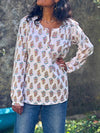
Indian block printing is an ancient art that dates back centuries. It involves printing designs onto fabrics using engraved wooden blocks. This artisanal process, although laborious, is renowned for its beauty and precision.
The production of the wooden blocks essential to this technique requires considerable expertise and plays a crucial role in the quality of the printed design. This begins with selecting the wood that will be used to make the block: teak and sheesham (a type of rosewood), and sometimes mango, are prized for their strength and durability. Their dense texture allows for the carving of fine details, essential for creating complex designs.
Next comes the drawing on the wood and then the engraving, a highly technical step carried out by an expert craftsman: this meticulous work can take days, even weeks, depending on the complexity of the design. Some blocks may have several levels of engraving to create relief effects and deeper details.
Several types of blocks are used to create designs with multiple layers and colors. Each type of block has a specific role in creating the final print.
- Contour block ("Rekha")
This block is used to print the outlines of the design. It is often engraved with fine, detailed lines, as it is responsible for defining the main shapes of the design. This is usually the first block used in a multi-color print.
- Filling block ("Gad")
Once the outline is printed, the fill block is used to apply colors within the outline lines. It can be engraved with simple shapes that fit perfectly within the outline block lines. It is often used to apply larger colors or secondary designs.
- Block of details or shadows ("Datta")
This block is used to add extra details, such as shadows or small, intricate designs, to already printed areas. It adds depth and contrast to the design.
- Background pattern block
To create background textures and patterns, a separate block is often used. These patterns can be geometric or floral and are applied before or after printing the main pattern, depending on the desired design.
- Border block ("Patti")
Used to print fabric borders, this block creates decorative frames around the main design. The borders can be repeated to form a continuous frame all the way around the printed fabric.
Once the blocks are engraved, the printing process begins. The artisan applies the dye to the block, then presses it against the fabric with even pressure. Each color in the design requires a separate block, and the prints are made in successive layers. Precise alignment of each block is essential to achieve a clear and harmonious pattern.
Hand-printing with woodblocks is a technique respected for its unique, artisanal quality. Each hand-printed piece is slightly different from the next, giving blockprinting its inimitable charm.




0 comments